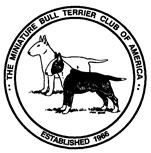|
Anesthesia in
Minis
As published in
the AKC Gazette
The Bull Terrier
and Mini Bull Terrier worlds owe a huge debt to researchers of BT behavior
problems, notably Dr. Nicholas Dodman and Dr. Alice Moon-Fanelli at Tufts. I
am not competent to detail their studies but would like to sketch
information gleaned from their talks because it has enormous implications
when BTs/MBT's need tranquilizers and anesthesia. The studies have been on
BTs but should apply equally to Minis.
A percentage of BTs
have behavior problems: seizures, unfocused staring, tail chasing, trancing,
fly-biting, extreme mood swings, fear of ordinary objects,
obsessive/compulsive behaviors, anxiety disorders, and occasionally rage
syndrome. Investigators have theorized genes for
epilepsy/obsessive-compulsive disorder. Usually the problem becomes obvious
as sex hormones kick in (6 months +). There are many environmental triggers:
lack of opportunity to express normal behavior, unfamiliar or unpredictable
environment, confinement in a small area, changes in the social group, and
physical stress including trauma, surgery, estrus, and whelping. The genes
appear to be spread through the Bull Terrier population with many
individuals being sub-clinical, or appearing normal.
How does this
relate to sedation and anesthesia? Some drugs lower the seizure threshold,
causing seizures/behavior problems in (genetically) seizure prone dogs. Ace
promazine (a common tranquilizer), ketamine (a frequently used
pre-anesthetic), and telazol lower the seizure threshold. Owners need to be
aware of the risks of using these drugs and need to discuss anesthesia,
preanesthesia, and tranquilization in detail with their vets each time they
are needed. Medical information is applicable to all dog breeds about 98
percent of the time. Veterinarians cannot be expected to know the 2 percent
of breed specific information as it applies to every dog. Dr. Dodman
recommends isofluorane as the anesthetic of choice in BTs. I believe
propafol and dormitor have also been used successfully.
I'm aware of
many cases of dogs showing problem behaviors after anesthesia but the one
that brought the seriousness of the problem home to me was the result of
morphiates (and ketamine?) used in a c-section. My apparently normal,
personable champion bitch was almost catatonic post surgery, not recognizing
people or surroundings. She wouldn't eat or drink. Over several months most
of her personality gradually returned. She was, however, left with rodent
mania that she had never before shown. She went from door to door in the
house wanting to go out. Outside, all her time was spent fence running
looking for imaginary rodents until captured and brought back inside. She
came through a subsequent c-section where only isofluorane was used without
problems.
I implore BT/MBT
owners to take responsibility for tranquilizers and anesthesia's
administered to their dogs. It isn't possible to predict at this time which
animals will be affected. And think very carefully about breeding from dogs
(or close relatives of dogs) that show any behavior problems no matter how
slightly affected.
Donly Chorn
40058 Hwy 45
Lake Villa, IL
60046 |
